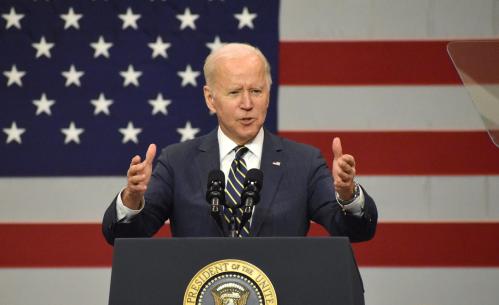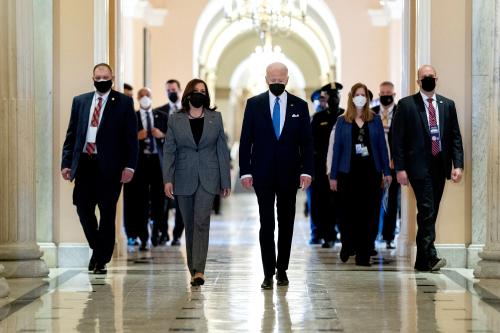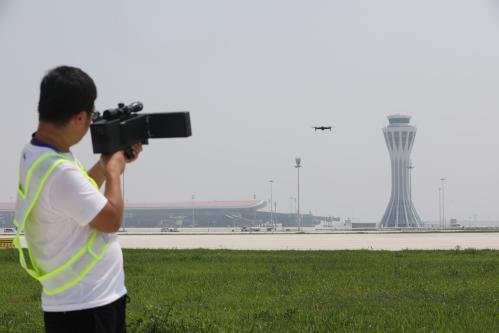Donald Trump deserves credit for championing the Federal Communication Commission’s (FCC) successful C-band auction and the 5G wireless broadband service it enabled. However, the recent rollout of 5G has been marred because of Federal Aviation Administration (FAA) concerns that should have been dealt with early on by the Trump Administration. Rather than facilitating a process for resolving those concerns, the Trump White House treated the FAA as a “swamp creature” to be vanquished. (Who knew wireless policy could be an opportunity to drain the swamp?) Moreover, the Trump Administration and its FCC failed to use a market mechanism that has helped resolve other spectrum disputes and that could have put this dispute in the rear-view mirror.
Marred Rollout of a Critical Technology
Having spent tens of billions of dollars for the rights to deploy 5G in the C-band, AT&T and Verizon were forced to delay and curtail the launch of their new service in recent weeks because of FAA concerns that 5G signals would interfere with the radio altimeters that planes rely on to land in low visibility. The FAA has now greenlighted the altimeters on 90 percent of the U.S. commercial fleet, but hundreds of flights on smaller planes have been cancelled, and the head of a foreign airline forced to scrub U.S.-bound flights said the debacle was “utterly irresponsible.” Although some Republicans are blaming President Biden for the disruption, it has everything to do with Donald Trump’s chaotic, institution-trashing approach to governance.
To his credit, Trump recognized that 5G was key to U.S. economic competitiveness and national security. In a 2019 appearance with the chairman of the FCC, Trump announced that “the race to 5G is on and we must win.” The Trump Administration made the C-Block auction a priority, with Larry Kudlow, the head of the National Economic Council (NEC), as the White House lead.
With support from the Trump White House, the FCC auctioned off the rights to operate 5G networks in a wide swath of underutilized spectrum in what is known as the C-band (3.7-3.98 gigahertz, or GHz). The bidding ran from December 2020 to February 2021; AT&T, Verizon and other winners paid $81 billion for the spectrum rights and another $13 billion to relocate incumbent satellite operators. Economists estimate that the benefits to consumers are ten times the auction value of spectrum rights, or nearly $1 trillion in the case of C-band-enabled 5G.
Spectrum “reallocation” (repurposing) such as what occurred through the C-band auction is critical. There is no more virgin spectrum. However, reallocation is also challenging because of the resistance from incumbents and the complaints from operators in adjacent bands about potential interference from new uses of the spectrum. Such operators often use aging technology designed to work under the status quo. The appearance of an intensive new neighboring use—such as 5G—can upset decades of expectations about the interference environment.
The FCC typically goes through an elaborate rulemaking process to hear these complaints, judge their validity, and make accommodations. In this case, the rulemaking, which began in 2018, surfaced concerns about radio altimeters operating in a globally harmonized section of the C-band above the proposed 5G swath (4.2-4.4 GHz). To protect the altimeters from interference from 5G, in its March 2020 Order, the FCC created a 220-megahertz guard band (3.98-4.2 GHz) between the two activities. This was more than twice what Boeing had said was necessary and in line with the protection provided by other countries that had already unveiled 5G.
NTIA and the FAA’s Failure to Engage
In addition to the FCC, the Department of Commerce’s National Telecommunications and Information Administration (NTIA) is a key player in many spectrum proceedings. NTIA oversees that portion of the radio spectrum used by the federal government (the FCC regulates only non-federal spectrum), and it serves as the Executive Branch’s intermediary to the FCC, which as an independent agency does not report to the President. Although the aviation uses at issue with 5G are commercial—and subject to FCC jurisdiction—the FAA had a strong interest in the C-band proceeding because it certifies aircraft equipment as part of its safety oversight role.
NTIA has deep technical expertise in spectrum, including a world-class lab in Boulder, CO, that routinely conducts interference testing. It also leads a 100-year-old interagency committee that coordinates federal spectrum use and resolves spectrum disputes among federal agencies and with the FCC. This committee was the logical forum in which to explore concerns about potential 5G interference with radio altimeters.
Unfortunately, the FAA eschewed the NTIA process and declined to tap NTIA technical experts. Instead, the FAA turned to outside analysts, who concluded that 5G could jeopardize aviation safety but whose analysis had serious flaws. In its March 2020 Order, the FCC criticized the first FAA-commissioned study, by the Aerospace Vehicle Systems Institute (AVSI), for using scenarios that assumed transmitter emission levels in excess of what the FCC’s own rules permit and for using an interference test that was triggered by other sources on the plane even before the simulated 5G signals were turned on. A second study, by the Radio Technical Commission for Aeronautics, which used inputs from the AVSI study, had similar methodological weaknesses.
When the Department of Transportation and the FAA finally went to NTIA in December 2020—asking it to engage with the FCC to defer the auction scheduled for later that month—they got the silent treatment. NTIA had a leadership problem. The agency was on its third acting administrator, its last Senate-confirmed head having been fired in May 2019. In addition, then-acting chief Adam Candeub said later he did not act on the request because the FAA’s interference analysis was so flawed.
Trump White House vs the “Swamp Creatures”
Another possible contributor to NTIA’s inaction was that the Trump White House had by then declared war on anyone seeking to delay or disrupt the pending auction. In a remarkable segment on his Fox Business program in December 2021, Trump NEC head Larry Kudlow boasted that he and former FCC Chairman Ajit Pai, a guest on the program, had defeated the FAA and the Department of Defense (DoD) on 5G—“We fought the Defense Department and we won,” Kudlow crowed. “We actually fought the FAA and we won that too, although they’re coming back with these ankle-biting letters.” Kudlow closed by dissing the “swamp creatures” who had challenged them on 5G. “That’s what they are; these deep-rooted bureaucrats are swamp creatures [who] hate change.”
In fairness, Kudlow also indicated that “we ignored them because the science said don’t worry about it,” referring to the FCC’s conclusion that a 220-megahertz guard band, combined with the FCC’s technical rules on power and emission limits, would prevent harmful interference to radio altimeters. But unlike previous Administrations, the Trump White House had no spectrum expert of its own—a critical gap. Moreover, the FCC’s Order had urged aviation groups to work with other stakeholders to identify and address any outlier cases, and that had not happened.
Trump’s drain-the-swamp strategy was not just unorthodox, it was dumb—because of the FAA’s ability to ground planes if it considered 5G unsafe, the agency had ultimate veto authority. When the FAA exercised that authority in recent weeks, Republican FCC Commissioner Brendan Carr lashed out at President Biden for emboldening the ankle-biters in the FAA that Trump had successfully muzzled—a remarkable attempt at partisan deflection.
That said, the FAA’s post-auction behavior (like its pre-auction, go-it-alone stance) is hard to defend. The FAA seems not to have engaged seriously with wireless carriers until late in the 5G staging process. The agency waited until November 2021, after AT&T and Verizon had installed their 5G base stations, to send up an official red flare. And the FAA’s recent clearances are based on tests and analysis the agency largely could have carried out a year ago.
Policy Lessons
The key lesson from the 5G rollout debacle is the need to combine high-level executive branch support with a ground-level interagency process that can distinguish cries of wolf from real concerns and address the latter. As Coleman Bazelon, an economist and spectrum expert with The Brattle Group, put it, “I don’t fault the Trump Administration for pushing C-band through. My take is that’s the only way a major spectrum reallocation happens. Their mistake was not having a process that surfaced and dealt with the real issues early on.”
The NTIA process is well-suited to an issue like radio altimeters and cellular interference, which has been long studied, is amenable to technical solutions, and affects a limited number of parties in a single sector (aviation). Moreover, a wealth of data is available from other countries, which have been rolling out 5G in the C-band without incident. The FAA’s failure to engage with the NTIA interagency committee was a major sin of omission.
Reports at the time suggested that the FAA did not trust NTIA to do the testing fairly or rigorously. Although such distrust was not merited, the FAA has a history of behaving as if no one outside the agency can understand its exacting safety standards. The Trump Administration’s White House-directed advocacy for 5G likely contributed to the distrust.
On a priority issue like 5G, the White House’s role is largely procedural—forcing federal agencies to work together or confer with industry groups to resolve differences that threaten achievement of the policy goal. The Biden NEC is playing that role on 5G now—and perhaps could have done so sooner—in an effort to clean up the mess left by the Trump Administration. By contrast, the Trump White House seems to have spurned that role in favor of a top-down strategy of directive and bullying. Because 5G was a regulatory matter for the FAA, the White House’s behavior was arguably improper as well as (ultimately) ineffective.[1]
The other policy lesson from the marred 5G rollout is the need for greater use of market-based approaches to dispute resolution—specifically compensation payments. The FCC used this tool to overcome resistance to the C-band auction from satellite incumbents. The auction winners were required to compensate satellite operators for the cost of new, more spectrum-efficient satellites, allowing the operators to reduce their footprint and move to a different part of the band. Compensation of incumbents has become routine. For example, in three separate FCC auctions—including one completed in December—DoD has received billions of dollars to upgrade military systems to free up spectrum.
Similarly, compensation can overcome resistance from spectrum operators in adjacent bands worried about the interference from new spectrum uses. Although the FCC has traditionally viewed transmitters as the sole source of interference, it is actually a reciprocal harm. Stated differently, it is often far less expensive to deal with interference by improving the receivers than by limiting the transmitters. Compensation payments—a strategy wireless carriers routinely use in negotiating with their spectrum neighbors—make win-win outcomes possible.
Surprisingly, in the 5G debate, aviation groups never put forward—nor do they appear to have been asked to put forward—a serious proposal for compensation to cover the cost of upgrading vulnerable altimeters. As the wireless carriers expand their footprint in the C-band (currently they are using only the lower third of the 5G swath), there may be a role for such compensation to finance equipment upgrades on a strict timetable. However, it will be more challenging to allocate funds now that the C-band auction is behind us.
Conclusion
A President can’t be expected to be an expert on issues like radio spectrum and aircraft altimeters. But he or she should be expected to make sure that the experts in the federal government are heard and that controversies between agencies are settled, whether through interagency fora or market-based mechanisms for dispute resolution. 5G’s hard landing is an example of what happens when a White House fails to do its job.
Footnote
[1] Presidents and their White House staff are generally careful not to interact with regulatory agencies about specific regulatory matters: a regulator’s effectiveness and credibility turns on its independence—both actual and perceived. President Trump violated that norm among many others. For example, in 2019, following the second crash of a Boeing 737 Max jet, Trump became the face of the safety probe, initiating multiple calls with Boeing and FAA officials. Trump even got out ahead of the FAA in announcing the agency’s decision to ground the 737 Max jets in the U.S. commercial fleet.
AT&T and Verizon are general, unrestricted donors to the Brookings Institution. The findings, interpretations, and conclusions posted in this piece are solely those of the author(s) and not influenced by any donation.






Commentary
Hard landing: Why the 5G rollout was so contentious and what we can learn from it
February 2, 2022